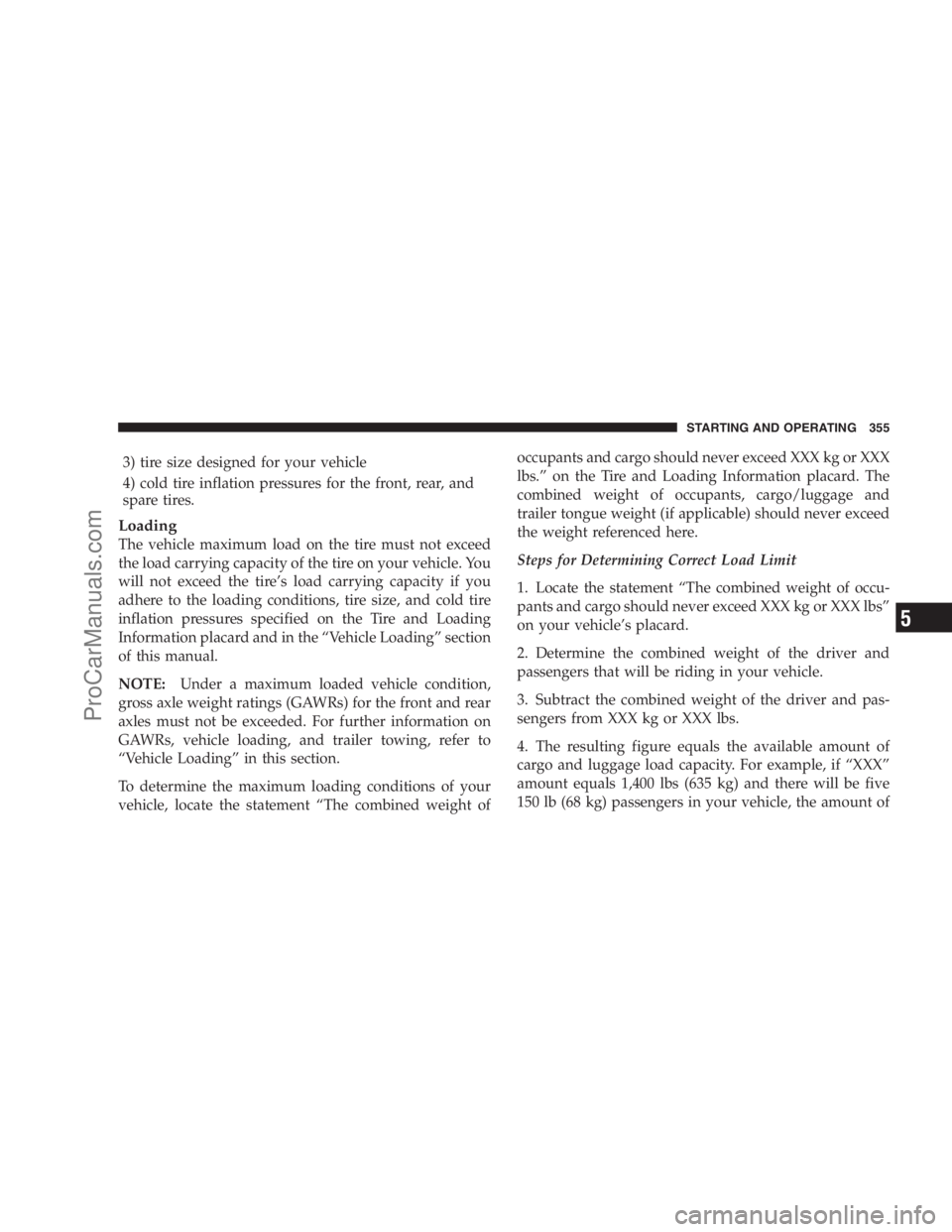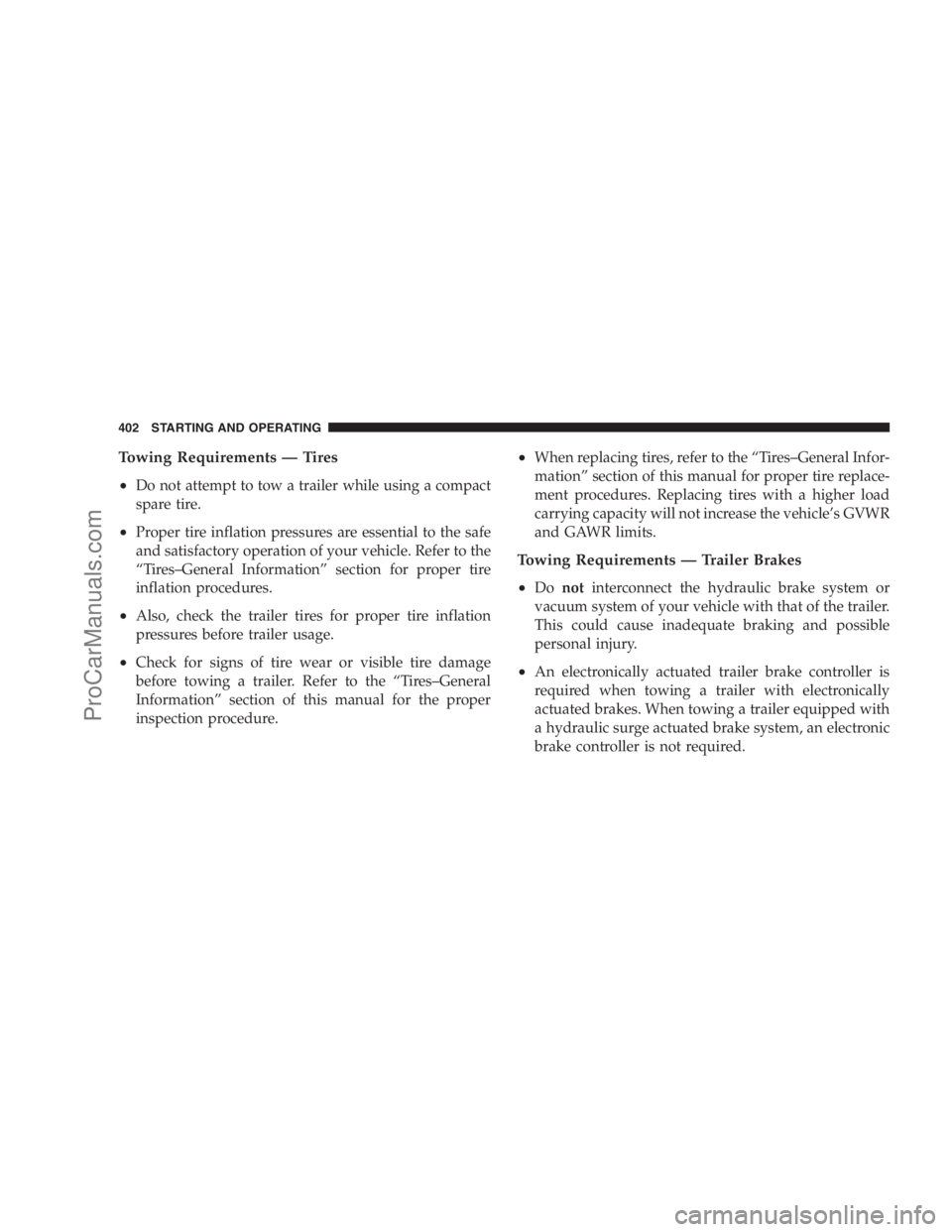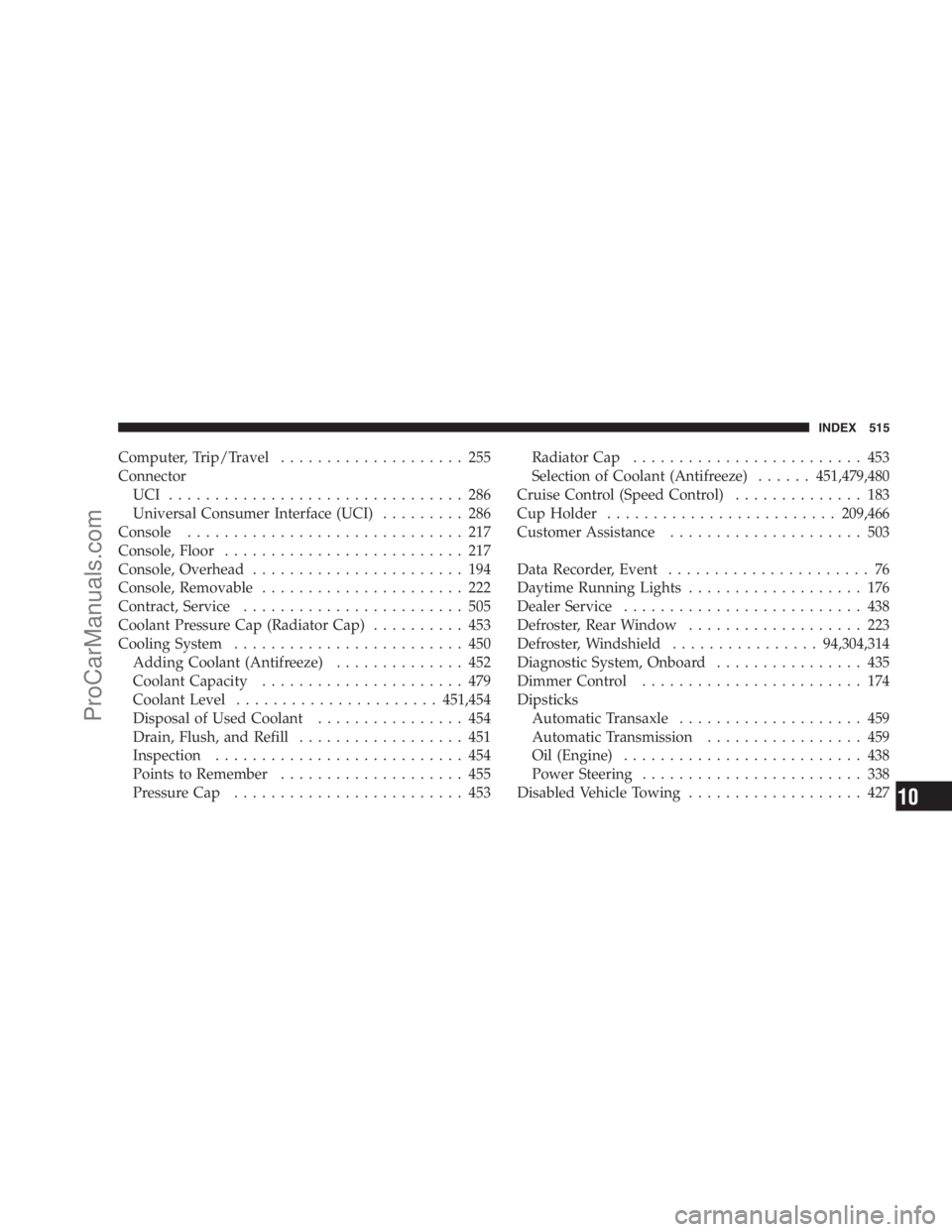2009 DODGE CARAVAN towing capacity
[x] Cancel search: towing capacityPage 357 of 534

3) tire size designed for your vehicle
4) cold tire inflation pressures for the front, rear, and
spare tires.
Loading
The vehicle maximum load on the tire must not exceed
the load carrying capacity of the tire on your vehicle. You
will not exceed the tire’s load carrying capacity if you
adhere to the loading conditions, tire size, and cold tire
inflation pressures specified on the Tire and Loading
Information placard and in the “Vehicle Loading” section
of this manual.
NOTE:Under a maximum loaded vehicle condition,
gross axle weight ratings (GAWRs) for the front and rear
axles must not be exceeded. For further information on
GAWRs, vehicle loading, and trailer towing, refer to
“Vehicle Loading” in this section.
To determine the maximum loading conditions of your
vehicle, locate the statement “The combined weight ofoccupants and cargo should never exceed XXX kg or XXX
lbs.” on the Tire and Loading Information placard. The
combined weight of occupants, cargo/luggage and
trailer tongue weight (if applicable) should never exceed
the weight referenced here.
Steps for Determining Correct Load Limit
1. Locate the statement “The combined weight of occu-
pants and cargo should never exceed XXX kg or XXX lbs”
on your vehicle’s placard.
2. Determine the combined weight of the driver and
passengers that will be riding in your vehicle.
3. Subtract the combined weight of the driver and pas-
sengers from XXX kg or XXX lbs.
4. The resulting figure equals the available amount of
cargo and luggage load capacity. For example, if “XXX”
amount equals 1,400 lbs (635 kg) and there will be five
150 lb (68 kg) passengers in your vehicle, the amount of
STARTING AND OPERATING 355
5
ProCarManuals.com
Page 358 of 534
![DODGE CARAVAN 2009 Owners Manual available cargo and luggage load capacity is 650 lbs
(295 kg) (since 5 x 150 = 750, and 1400 – 750 = 650 lbs
[295 kg]).
5. Determine the combined weight of luggage and cargo
being loaded on the vehi DODGE CARAVAN 2009 Owners Manual available cargo and luggage load capacity is 650 lbs
(295 kg) (since 5 x 150 = 750, and 1400 – 750 = 650 lbs
[295 kg]).
5. Determine the combined weight of luggage and cargo
being loaded on the vehi](/manual-img/12/57747/w960_57747-357.png)
available cargo and luggage load capacity is 650 lbs
(295 kg) (since 5 x 150 = 750, and 1400 – 750 = 650 lbs
[295 kg]).
5. Determine the combined weight of luggage and cargo
being loaded on the vehicle. That weight may not safely
exceed the available cargo and luggage load capacity
calculated in Step 4.
6. If your vehicle will be towing a trailer, load from your
trailer will be transferred to your vehicle. Consult this
manual to determine how this reduces the available
cargo and luggage load capacity of your vehicle.NOTE:
•The following table shows examples on how to calcu-
late total load, cargo/luggage, and towing capacities
of your vehicle with varying seating configurations
and number and size of occupants. This table is for
illustration purposes only and may not be accurate for
the seating and load carry capacity of your vehicle.
•For the following example, the combined weight of
occupants and cargo should never exceed 865 lbs
(392 kg).
356 STARTING AND OPERATING
ProCarManuals.com
Page 404 of 534

Towing Requirements — Tires
•
Do not attempt to tow a trailer while using a compact
spare tire.
•Proper tire inflation pressures are essential to the safe
and satisfactory operation of your vehicle. Refer to the
“Tires–General Information” section for proper tire
inflation procedures.
•Also, check the trailer tires for proper tire inflation
pressures before trailer usage.
•Check for signs of tire wear or visible tire damage
before towing a trailer. Refer to the “Tires–General
Information” section of this manual for the proper
inspection procedure.
•When replacing tires, refer to the “Tires–General Infor-
mation” section of this manual for proper tire replace-
ment procedures. Replacing tires with a higher load
carrying capacity will not increase the vehicle’s GVWR
and GAWR limits.
Towing Requirements — Trailer Brakes
•
Donotinterconnect the hydraulic brake system or
vacuum system of your vehicle with that of the trailer.
This could cause inadequate braking and possible
personal injury.
•An electronically actuated trailer brake controller is
required when towing a trailer with electronically
actuated brakes. When towing a trailer equipped with
a hydraulic surge actuated brake system, an electronic
brake controller is not required.
402 STARTING AND OPERATING
ProCarManuals.com
Page 405 of 534

•Trailer brakes are recommended for trailers over
1,000 lbs (454 kg) and required for trailers in excess of
2,000 lbs (907 kg).
CAUTION!
If the trailer weighs more than 1,000 lbs (454 kg)
loaded, it should have its own brakes and they
should be of adequate capacity. Failure to do this
could lead to accelerated brake lining wear, higher
brake pedal effort, and longer stopping distances.
WARNING!
•Do not connect trailer brakes to your vehicle’s
hydraulic brake lines. It can overload your brake
system and cause it to fail. You might not have
brakes when you need them and could have an
accident.
(Continued)
WARNING! (Continued)
•Towing any trailer will increase your stopping
distance. When towing you should allow for addi-
tional space between your vehicle and the vehicle
in front of you. Failure to do so could result in an
accident.
Towing Requirements — Trailer Lights and Wiring
Whenever you pull a trailer, regardless of the trailer size,
stop lights and turn signals on the trailer are required for
motoring safety.
The Trailer Tow Package may include a four-pin or a
seven-pin wiring harness. Use a factory approved trailer
harness and connector.
NOTE:Do not cut or splice wiring into the vehicles
wiring harness.
STARTING AND OPERATING 403
5
ProCarManuals.com
Page 517 of 534

Computer, Trip/Travel.................... 255
Connector
UCI ................................ 286
Universal Consumer Interface (UCI)......... 286
Console.............................. 217
Console, Floor.......................... 217
Console, Overhead....................... 194
Console, Removable...................... 222
Contract, Service........................ 505
Coolant Pressure Cap (Radiator Cap).......... 453
Cooling System......................... 450
Adding Coolant (Antifreeze).............. 452
Coolant Capacity...................... 479
Coolant Level......................451,454
Disposal of Used Coolant................ 454
Drain, Flush, and Refill.................. 451
Inspection........................... 454
Points to Remember.................... 455
Pressure Cap......................... 453Radiator Cap......................... 453
Selection of Coolant (Antifreeze)......451,479,480
Cruise Control (Speed Control).............. 183
Cup Holder.........................209,466
Customer Assistance..................... 503
Data Recorder, Event...................... 76
Daytime Running Lights................... 176
Dealer Service.......................... 438
Defroster, Rear Window................... 223
Defroster, Windshield................94,304,314
Diagnostic System, Onboard................ 435
Dimmer Control........................ 174
Dipsticks
Automatic Transaxle.................... 459
Automatic Transmission................. 459
Oil (Engine).......................... 438
Power Steering........................ 338
Disabled Vehicle Towing................... 427
INDEX 515
10
ProCarManuals.com
Page 530 of 534

Flat Changing........................ 421
General Information.................... 358
High Speed.......................... 360
Inflation Pressures..................... 359
Jacking...........................412,415
Life of Tires.......................... 364
Load Capacity.....................354,355
Pressure Monitor System (TPMS)........... 370
Pressure Warning Light.................. 245
Quality Grading....................... 509
Radial.............................. 361
Replacement......................... 365
Rotation............................. 369
Safety...........................349,358
Sizes............................... 350
Snow Tires........................... 368
Spare Tire........................... 413
Spinning............................ 363
Tread Wear Indicators................... 364Tongue Weight/Trailer Weight.............. 399
Towing............................... 393
24-Hour Towing Assistance............... 129
Disabled Vehicle....................... 427
Guide.............................. 398
Recreational.......................407,429
Weight.............................. 398
Towing Assistance....................... 129
Traction Control......................... 345
Traction Control Switch................... 345
Trailer Towing.......................... 393
Cooling System Tips.................... 406
Hitches............................. 397
Minimum Requirements................. 400
Trailer and Tongue Weight................ 399
Wiring.............................. 403
Trailer Towing Guide..................... 398
Trailer Weight.......................... 398
Transaxle............................. 327
528 INDEX
ProCarManuals.com